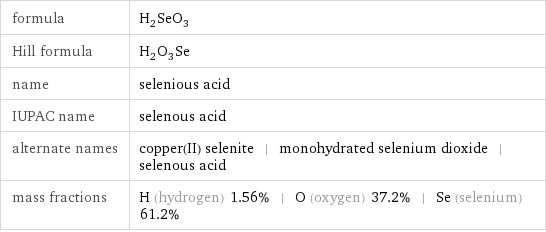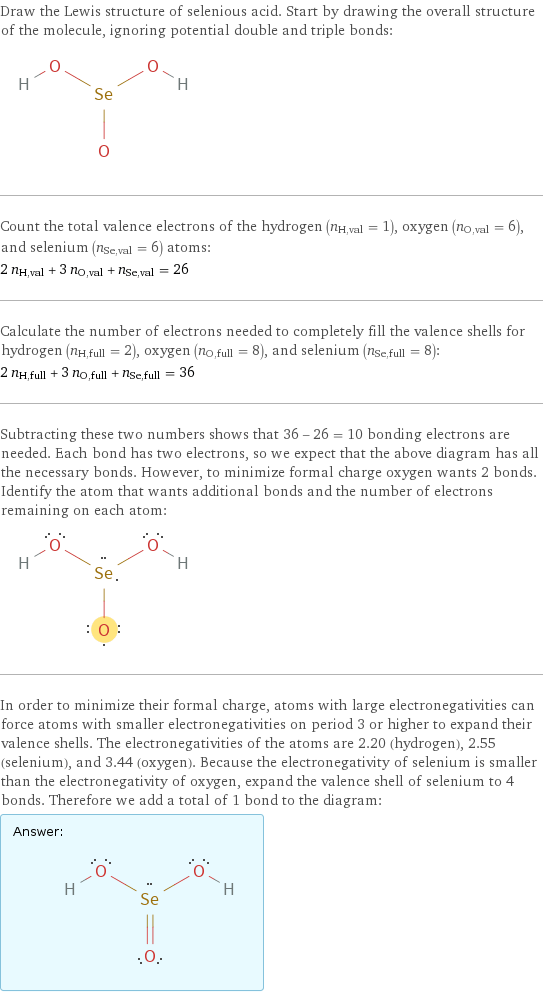Input interpretation

selenious acid
Chemical names and formulas

formula | H_2SeO_3 Hill formula | H_2O_3Se name | selenious acid IUPAC name | selenous acid alternate names | copper(II) selenite | monohydrated selenium dioxide | selenous acid mass fractions | H (hydrogen) 1.56% | O (oxygen) 37.2% | Se (selenium) 61.2%
Lewis structure

Draw the Lewis structure of selenious acid. Start by drawing the overall structure of the molecule, ignoring potential double and triple bonds: Count the total valence electrons of the hydrogen (n_H, val = 1), oxygen (n_O, val = 6), and selenium (n_Se, val = 6) atoms: 2 n_H, val + 3 n_O, val + n_Se, val = 26 Calculate the number of electrons needed to completely fill the valence shells for hydrogen (n_H, full = 2), oxygen (n_O, full = 8), and selenium (n_Se, full = 8): 2 n_H, full + 3 n_O, full + n_Se, full = 36 Subtracting these two numbers shows that 36 - 26 = 10 bonding electrons are needed. Each bond has two electrons, so we expect that the above diagram has all the necessary bonds. However, to minimize formal charge oxygen wants 2 bonds. Identify the atom that wants additional bonds and the number of electrons remaining on each atom: In order to minimize their formal charge, atoms with large electronegativities can force atoms with smaller electronegativities on period 3 or higher to expand their valence shells. The electronegativities of the atoms are 2.20 (hydrogen), 2.55 (selenium), and 3.44 (oxygen). Because the electronegativity of selenium is smaller than the electronegativity of oxygen, expand the valence shell of selenium to 4 bonds. Therefore we add a total of 1 bond to the diagram: Answer: | |
3D structure

3D structure
Basic properties

molar mass | 128.98 g/mol phase | solid (at STP) melting point | 70 °C boiling point | 315 °C density | 3.004 g/cm^3
Units

Solid properties (at STP)

density | 3.004 g/cm^3 vapor pressure | 2 mmHg
Units

Chemical identifiers
O InChI identifier | InChI=1/H2O3Se/c1-4(2)3/h(H2, 1, 2, 3)/f/h1-2H RTECS number | VS7175000 MDL number | MFCD00011331](../image_source/51b0e5abb3da6224c53697aacb595e0b.png)
CAS number | 7783-00-8 PubChem CID number | 1091 PubChem SID number | 24852658 SMILES identifier | O[Se](=O)O InChI identifier | InChI=1/H2O3Se/c1-4(2)3/h(H2, 1, 2, 3)/f/h1-2H RTECS number | VS7175000 MDL number | MFCD00011331
Toxicity properties

lethal dosage | 25 mg/kg (oral dose for rats)

probable lethal dose for man | 4 mL (milliliters) RTECS classes | agricultural chemical and pesticide | mutagen